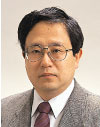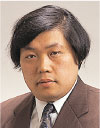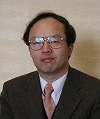 |
 |
 |
 |
Professor |
Professor |
Associate Professor |
Associate Professor |
 |
 |
 |
 |
Associate Professor |
Assistant Professor |
Assistant Professor |
Assistant Professor |
 |
 |
||
Assistant Professor |
Assistant Professor |
|
The scope of activities of the Center for Mathematical Sciences spans all aspects of research and education in the fields of mathematical sciences. Our current researches in the field of mathematics are devoted to various subjects and problems arising in both pure and applied mathematics: non-associative algebras, neural networks, unimodality problems, algebraic combinatorics, spherical functions, homotopy theory, and arithmetic theory. In the fields of physics, theoretical research is performed in many-body theories, nuclear physics, quantum gravity and quantum mechanics of constrain system. There has been also a project to develop educational textbooks and software for mechanics, electromagnetism and quantum mechanics. The research areas assigned to each co-researcher are as follows:
|
Refereed Journal Papers
| [k-asai-01:2006] |
Kazuto Asai. Homogeneous partial differential equations for superpositions of indeterminate functions of several variables. Izvestiya Rossiiskoi Akademii Nauk. Seriya Matematicheskaya, submitted 2007/2. |
| status: accepted |
|
| [m-honma-01:2006] |
M. A. G. Silveira, N. H. Medina, J. R. B. Oliveira, J. A. Alcantara-Nfu nez, E. W. Cybulska, H. Dias, M. N. Rao, R. V. Ribas, W. A. Seale, K. T. Wiedemann, B. A. Brown, M. Honma, T. Mizusaki, and T. Otsuka. 58Co: Structure of an odd-odd nucleus in the pf shell. Phys. Rev. C, 74:064312/1-10, 2006. |
| High-spin states in the odd-odd 58Co nucleus have been studied with the fusion-evaporation reaction 51V (10B,p2n) using the gamma-spectrometer Saci-Perere. Thirty-six new excited states up to spin 11+ and an excitation energy of 8.0 MeV have been observed, which are connected by 46 gammaray transitions. Transition probabilities for 14 excited states were measured through the Doppler-shift attenuation method. The results are compared with shell-model calculations using the GXPF1 effective interaction, developed for use in the pf shell. These results were interpreted by considering particle-hole excitations with respect to the doubly magic N=Z=28 core. |
|
| [m-honma-02:2006] |
S. Zhu, A. N. Deacon, S. J. Freeman, R. V. F. Janssens, B. Fornal, M. Honma, F. R. Xu, R. Broda, I. R. Calderin, M. P. Carpenter, P. Chowdhury, F. G. Kondev, W. KrLolas, T. Lauritsen, S. N. Liddick, C. J. Lister, P. F.Mantica, T. Pawlat, D. Seweryniak, J. F. Smith, S. L. Tabor, B. E. Tomlin, B. J. Varley, and J. Wrzesinski. Level structure of the neutron-rich 56,58,60Cr isotopes: Single-particle and collective aspects. Phys. Rev. C, 74:064315/1-15, 2006 |
| The structure of the 56,58,60Cr nuclei was investigated at Gammasphere using both deep inelastic and fusion-evaporation reactions. As a result of this work, expanded level schemes are now available for these three neutron-rich, eveneven isotopes. Experimental signatures were found for both single-particle and collective excitations whose relative importance varies with neutron number. Together with recent structural information on the odd-A 55,57,59Cr neighbors, the present data highlight the changing role of the g9/2 orbital with neutron number. Comparisons with shell-model calculations using the recently developed GXPF1A interaction and with total Routhian surface calculations are presented. |
|
| [m-honma-03:2006] |
M. Horoi, B. A. Brown, T. Otsuka, M. Honma, and
T. Mizusaki. Shell model analysis of the 56Ni spectrum in the full
pf model space. Phys. Rev. C, 73:061305(R)/1-4, 2006. |
| We present a full pf-shell spectroscopy of the low-lying states of 56Ni using the GXPF1A interaction. Both the ground-state band and the first deformed band, as well as the transition probabilities, compare favorably with the experimental data.We analyze the significance of the contributions of N-particle N-hole configurations to the full model calculations, similarly to the analysis obtained for 28Si in the sd shell some 20 years ago. |
|
| [sagawa-01:2006] |
Satoshi Yoshida and Hiroyuki Sagawa. Isovector nuclear matter properties and neutron skin thickness. Phys. Rev. C, 73:044320/1-12, 2006. |
| Correlations among several nuclear matter propertiesare investigated in theSkyrme Hartree-Fock (SHF) and the relativistic mean field (RMF) models. The Skyrme parameters are related analytically to the isoscalar and theisovector nuclear matter properties of the Hamiltonian density.Linear correlations are found among the isovector nuclear matter properties ofthe Hamiltonian density in both the SHF and the RMF models.We show analytically a singularity at the incompressibility Kc = 306 MeVin correlations between the isovector nuclear matter propertiesand the incompressibility with the SHF model, whereas we could not see anyobvious singularity in those correlations with the RMF model.A linear correlation between the neutron skin thickness and the pressure of theneutron matter is given in terms of the ratio between the neutron and nuclearmatter densities in the SHF model.We show that the neutron skin thickness gives crucial information about notonly the neutron EOS but also the isovector nuclear matter properties and theparameterization of Skyrme interaction. |
|
| [sagawa-02:2006] |
H. Sagawa and K. Hagino. Pairing correlations and soft dipole excitationsin nuclei on the neutron-drip line. Physics of Atomic Nuclei, 70:1-9, 2007. |
| Paring correlations and soft dipole excitationsin weakly bound nuclei on the edge of neutron drip lineare studied by usinga three-body model.A densitydependent contact interaction is employedto calculate the ground state ofhalo nuclei 6He and 11Li, as well as a skin nucleus 24O.Dipole excitations in these nuclei are also studied within the samemodel.We point out that the di-neutron type correlationplays a dominant role in the halo nuclei 6He and 11Lihaving the coupled spin of the two neutronsS=0, while thecorrelation similarto the BCS type is important in 24O. Contributions ofthe spin S=1 and S=0 configurationsare separately discussed in the low energy dipole excitations. The calculated results are compared withrecent experimental data of 6He and 11Li. |
|
| [sagawa-03:2006] |
Jie Meng WenHui Long, Hiroyuki Sagawa and Nguyen Van Giai. Pseudo-spin symmetry in density-dependent relativistic Hartree-Fock theory. Phys. Lett. B, 639:242-247, 2006. |
| The pseudo-spin symmetry (PSS) is investigated in the densitydependentrelativistic Hartree-Fock theory by taking the doubly magic nucleus132Sn as a representative. It is found that the Fock terms bringsignificant contributions to the pseudo-spin orbital potentials (PSOP) and makeit comparable to the pseudo-centrifugal barrier (PCB). However, these Fockterms in the PSOP are counteracted by other exchange terms due to thenonlocality of the exchange potentials. The pseudo-spin orbital splittingindicates that the PSS is preserved well for the partner states lrbË3s1/2, Ë2d3/2 of 132Sn in the relativistic Hartree-Fock theory. |
|
| [sagawa-04:2006] |
H. Sagawa I. Hamamoto and Xian-Rong Zhou. Weakly-bound neutrons and quadrupole response function]Weakly-bound neutronsand quadrupole response functionin the many-body pair-correlation of neutron drip line nuclei. Journal of Physics G, 32:1-15, 2006. |
| A simplified model of the Hartree-Fock Bogoliubov (HFB) equationwith surface-type or volume-type pairing is solved in coordinatespace with the correct asymptotic boundary conditions. By usingthe resulting HFB wavefunctions, the low-energy quadrupole (L=2)response function is studied for the system with weakly-bound sand d neutrons. As the binding energy of the neutrons becomessmall or approaches zero, the discrete solutions of the HFBequation disappear. Then, without any furthercorrelation (for example, random phase approximation (RPA) correlation) |
|
| [sagawa-05:2006] |
F. Bortignon G. ColLo, S. Fracasso and H. Sagawa. Spin-orbit splitting and Tensor interactions in Skyrme Interaction. Physics Letters, 646:227-231, 2007. |
| We study the role of tensor interactions in Skyrme effectiveinteraction on the spin-orbit splittings of N=82 isotones and Z=50 isotope.The different role of the triplet-even and triplet-odd tensorforces is pointed out in the spinorbit splittings in these nuclei.The isospin dependenceof the shell structure is well described as the results ofthe tensor interactions without destroying good properties ofthe binding energy and the rms charge radii of the heavy nuclei. The isotope shifts of rms radii of Pb nuclei and the Gamow-Tellerstates are also discussed with the tensor interactions. |
|
| [sagawa-06:2006] |
X. Z. Zhang H. Sagawa andF. R. Xu C. L. Zhang, H. Q. Zhang. Polarization charge of O isotopes. Journal of Physics G, 32:2261-2271, 2006. |
| Isospin-dependence of polarization charges in O isotopes are studied basedon a microscopic model. The effects of different dynamical structure at agiven excitation energy on polarization charges are discussed. |
|
| [sagawa-07:2006] |
S. Yoshida K. Yako, H. Sagawa and H. Sakai. Neutron Skin Thickness of 90ZrDetermined By the Charge Exchange Reactions. Phys. Rev. C, 74:051303/1-4, 2006. |
| Charge exchange spin-dipole (SD) excitationsof 90Zr are studied by the 90Zr(p, n) and 90Zr(n, p) reactions at 300 MeV.A multipole decomposition technique is employed to obtainthe SD strength distributions in the cross section spectra.For the first time, a model-independentSD sum rule value is obtained: 148 } 12 fm2.The neutron skin thickness of 90Zr is determined to be0.07 } 0.04 fm from the SD sum rule value. |
|
| [sigeru-w-01:2006] |
Shigeru Watanabe. Symmetric pairs, Gelfand pairs and pairs such that generating functions of zonal spherical functions define unitary operators\the case of the compact type. Journal of Functional Analysis, 238(2):427-446, 2006. |
| We show that a new notion which is equivalent neither to that of Riemannian symmetric pair nor to that of Gelfand pair can be defined by generating functions. |
|
| [t-watanb-01:2006] |
T. Watanabe. Exact Hausdorff measure on the boundary of a
Galton-Watson tree. Ann. Probab., 35(3):1007-1038, 2007. |
| A necessary and sufficient condition for the almost sure existence of an absolutely continuous (with respect to the branching measure) exact Hausdorff measure on the boundary of a Galton-Watson tree is obtained. In the case where the absolutely continuous exact Hausdorff measure does not exist almost surely, a criterion which classifies gauge functions ph according to whether ph-Hausdorff measure of the boundary minus a certain exceptional set is zero or infinity is given. Important examples are discussed in four additional theorems. In particular, Hawkesfs conjecture in 1981 is solved. Problems of determining the exact local dimension of the branching measure at a typical point of the boundary are also solved. |
|
| [t-watanb-02:2006] |
T. Watanabe. Asymptotic estimates of multi-dimensional stable densities and their application. Trans. Amer. Math. Soc., 359(6):2851-2879, 2007. |
| The relation between the upper and lower asymptotic estimates of the density and the fractal dimensions on the sphere of the spectral measure for a multivariate stable distribution is discussed. In particular, the problem and the conjecture on the asymptotic estimates of multivariate stable densities in the work of Pruitt and Taylor in 1969 are solved. The proper asymptotic orders of the stable densities in the case where the spectral measure is absolutely continuous on the sphere, or discrete with the support being a finite set, or a mixture of such cases are obtained. Those results are applied to the moment of the last exit time from a ball and the Spitzer type limit theorem involving capacity for a multi-dimensional transient stable process. |
Refereed Proceeding Papers
| [m-honma-04:2006] |
T. Mizusaki M. Honma, T. Otsuka and M. Hjorth-Jensen. Effective interaction for f5pg9-shell nuclei and two-neutrino double betadecay matrix elements. In T. Otuska M. Honma and Editor N. Aoi, editors, The International Symposium on Structure of Exotic Nuclei and Nuclear Forces, pages 45-50. IOP, 2006. |
| We have developed an effective interaction for shell model calculations in the model space consisting of four orbits 1p3/2, 0f5/2, 1p1/2 and 0g9/2. Starting from a renormalized G-matrix interaction, we have modified 45 linear combinations of Hamiltonian parameters by fitting to 400 experimental binding and excitation energy data out of 87 nuclei with masses A=63-96. The resultant effective interaction is shown to be successful for describing irregular behavior of the 02+ states in Ge isotopes. We have evaluated the two-neutrino double-beta-decay matrix elements for 76Ge and 82Se which are in reasonable agreement with the experimental data. |
Academic Activities
| [sigeru-w-02:2006] |
Shigeru Watanabe, 2007. Reviewer of Mathematical Reviews published by AmericanMathematical Society |
Ph.D, Master and Graduation Theses
| [sagawa-08:2006] |
Koujiro Aogaki. Graduation Thesis: Quantum Comoputer implemented by a single electronspin, University of Aizu, 2006. Thesis Advisor: H. Sagawa |
| [sagawa-09:2006] |
Makoto Tamura. Graduation Thesis: Comparison between RSA code andquantum cryptography, University of Aizu, 2006. Thesis Advisor:H. Sagawa |
| [sagawa-10:2006] |
Masanori Shiba. Graduation Thesis: Quantum Cryptography in Differential-Phase-ShiftQuantum Key Distribution, University of Aizu, 2006. Thesis Advisor:H. Sagawa |
| [sigeru-w-03:2006] |
Kouichi Monma. Graduation Thesis: New Functions Associated with Legendere Polynomials, University of Aizu, 2006. Thesis Advisor: Watanabe, S |
| [sigeru-w-04:2006] |
Youhei Nishida. Graduation Thesis: New Special Functions associated with Hermite Polynomials, University of Aizu, 2006. Thesis Advisor: Watanabe, S |
| [sigeru-w-05:2006] |
Daisuke Ugajin. Graduation Thesis: New Functions Defined by Generating Functions, University of Aizu, 2006. Thesis Advisor: Watanabe, S |
| [sigeru-w-06:2006] |
Fumiyuki Go. AGraduation Thesis: New System of Functions obtained by Frobenius Method, University of Aizu, 2006. Thesis Advisor: Watanabe, S |
| [sigeru-w-07:2006] |
Azusa Yashima. Graduation Thesis: New Functions Defined by a Generating Function Associated with Legendre polynomials, University of Aizu, 2006. Thesis Advisor: Watanabe, S |
Others
| [kihara-01:2006] |
Hiroshi Kihara. Cartesian closedness in geometry, November 2006. Symposium on Homotopy Theory |
